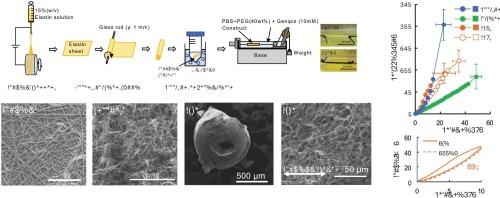A novel method to fabricate elastin/collagen fiber composites: Proof of concept
IF 2.6
Q3 MATERIALS SCIENCE, MULTIDISCIPLINARY
引用次数: 0
Abstract
Collagen and elastin are the main fibrous proteins of load-bearing soft tissues, conferring extensibility and strength upon those tissues through their interactions. However, to date, only a few techniques have been developed to fabricate fiber composites made from these proteins. Here we present an original method of fabricating fibrous composites of collagen and elastin and characterize their mechanical behavior. Soluble elastin was electrospun to form a sheet of elastin fibers, which was rolled and submerged in an acidic solution of collagen to permit collagen infiltration. The construct was incubated at 37 °C for 1 h so that collagen fibers self-assembled into the elastin fiber network, forming an elastin/collagen fiber composite. Simultaneous application of static mechanical loading and a chemical cross-linker, genipin, to the construct for an additional 24 h was also performed for fiber alignment. SEM observation revealed that elastin and collagen fibers were well integrated, although effects of mechanical loading to align those fibers were not observed. These elastin/collagen fiber composites possessed mechanical properties between those of collagen and elastin. Tensile properties benefited from collagen, whereas viscoelastic properties were derived from elastin. This method can be applied to development of artificial replacements of load-bearing soft tissues, such as tendon and meniscus.

一种制造弹性蛋白/胶原纤维复合材料的新方法:概念验证
胶原蛋白和弹性蛋白是承重软组织的主要纤维蛋白,通过它们的相互作用赋予这些组织延展性和强度。然而,到目前为止,只有少数技术被开发出来制造由这些蛋白质制成的纤维复合材料。本文提出了一种制备胶原蛋白和弹性蛋白纤维复合材料的新方法,并对其力学性能进行了表征。可溶性弹性蛋白被电纺成一层弹性蛋白纤维,把它卷起来,浸入酸性的胶原蛋白溶液中,使胶原蛋白浸润。将构建物在37℃下孵育1 h,使胶原纤维自组装成弹性蛋白纤维网络,形成弹性蛋白/胶原纤维复合物。同时应用静态机械载荷和化学交联剂genipin对结构进行额外的24小时,以进行纤维对准。扫描电镜观察显示,弹性蛋白和胶原纤维很好地结合在一起,尽管没有观察到机械载荷对这些纤维排列的影响。弹性蛋白/胶原纤维复合材料具有介于胶原蛋白和弹性蛋白之间的力学性能。拉伸性能得益于胶原蛋白,而粘弹性性能源于弹性蛋白。该方法可应用于开发人工替代承重软组织,如肌腱和半月板。
本文章由计算机程序翻译,如有差异,请以英文原文为准。
求助全文
约1分钟内获得全文
求助全文

 求助内容:
求助内容: 应助结果提醒方式:
应助结果提醒方式:


